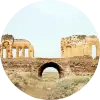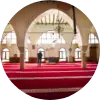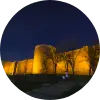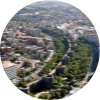
















Mesudiye Madrasa is an important madrasa complex built between 1198 and 1223 by the Artuqid Beylik. Construction of the madrasa began in 1198 during the reign of Artuqid ruler Abu Muzaffer Sökmen and was completed during the time of Mevdud, also known as Melik Mesud, in 1123. This impressive structure was designed by Halepli Usta Cafer Bin Mahmud.
It is noted that various subjects were taught in the madrasa. According to its inscription, Mesudiye Madrasa offered a wide range of courses including Islamic jurisprudence, medicine, physics, mathematics, biology, chemistry, literature, and philosophy.
The madrasa has two entrances. One opens towards the Grand Mosque, while the main entrance is located to the north of the madrasa. Constructed with cut stones and in two stories, the building features a courtyard with a plan close to a square, highlighted by a large triple-arched portico on its southern side.
The rotating stone columns placed on either side of the mihrab in the courtyard were carefully placed to prevent the building from collapsing. These details reflect the architectural intelligence and craftsmanship of the period.
Mesudiye Madrasa served not only as a structure of historical significance but also as a center for education and training in various scientific and artistic disciplines. Therefore, the madrasa holds great importance not only from an architectural perspective but also for its role in the history of education and culture.